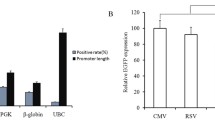Abstract
Currently available vectors for mammalian cells suffer from a number of limitations which make them only partially useful for genetic modification of eukaryotic cells and organisms and for gene therapy. While integration of a vector can lead to unpredictable interactions with the host genome and silencing of the integrated transgene, most non-integrating vectors mediate only transient expression of a transgene. All available vector types can lead to transformation of the recipient cell and many of them can cause serious immunological side effects in the organism. The ideal vector has to be free of these side effects and should allow long-term expression of a transgene in the absence of selection.
In this report we describe a novel non-viral episomal expression system fulfilling these criteria. The gene encoding the truncated rat NGF-receptor gene under the control of the CMV-promoter was inserted into a vector construct containing a scaffold/matrix attached region (S/MAR). This vector was then transfected into CHO cells and human HaCat cells. We show that this vector replicates episomally in these cells and is mitotically stable in the abscence of selection over more than 100 generations. Moreover, we provide the first experimental data that the CMV-promoter in an episome is not subject to silencing by cytosine methylation, thus allowing long-term expression of the transgene in the absence of selection.
Similar content being viewed by others
References
Kay MA, Glorioso JC & Naldini L (2001) Nat Med 7: 33–40.
Marshall E (2002) Science 298: 510–1.
Check E (2002) Nature 420: 735.
Somia N & Verma IM (2000) Nat Rev Genet 1: 91–9.
Nakai H et al. (2003) Nat Genet 34: 297–302.
Di Mayorca G., Callender J, Marin G and Giordano R (1969) Virology 38: 126–33.
Lipps HJ et al. (2003) Gene 304: 23–33.
Piechaczek C et al. (1999) Nucleic Acids Res. 27: 426–8.
Baiker A et al. (2000) Nat. Cell. Biol. 2: 182–4.
Jenke BH et al. (2002) EMBO Rep. 3: 349–54.
Stehle IM et al. (2003) Chrom. Res. 11: 413–421.
Teschendorf C, Warrington KH, Jr Siemann DW and Muzyczka N (2002) Anticancer Res. 22: 3325–30.
Radeke MJ et al (1987) Nature 325: 593–7.
Southern EM (1975) J. Mol. Biol. 98: 503–17.
Southern EM, Maskos U & Elder JK (1992) Genomics 13: 1008–17.
Boukamp P et al. (1988) J. Cell. Biol. 106: 761–71.
Prosch S et al. (1996) Biol. Chem. Hoppe Seyler 377: 195–201.
Collas P (1998) Nucleic Acids Res. 26: 4454–61.
Dang Q, Auten J & Plavec I (2000) J. Virol. 74: 2671–8.
Author information
Authors and Affiliations
Rights and permissions
About this article
Cite this article
Jenke, A.C., Scinteie, M.F., Stehle, I.M. et al. Expression of a transgene encoded on a non-viral episomal vector is not subject to epigenetic silencing by cytosine methylation. Mol Biol Rep 31, 85–90 (2004). https://doi.org/10.1023/B:MOLE.0000031363.35839.46
Issue Date:
DOI: https://doi.org/10.1023/B:MOLE.0000031363.35839.46




